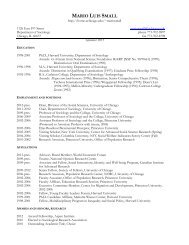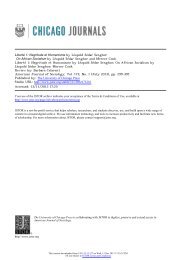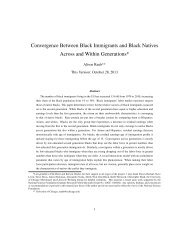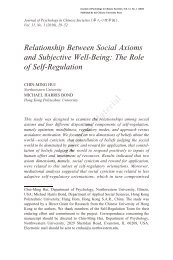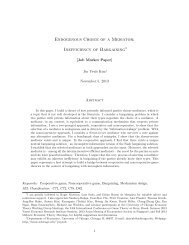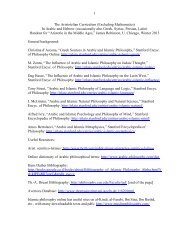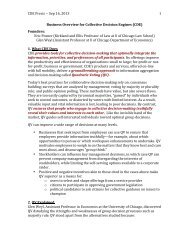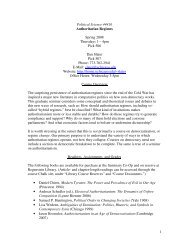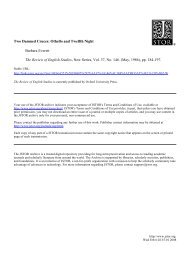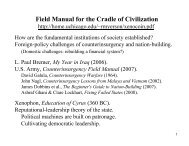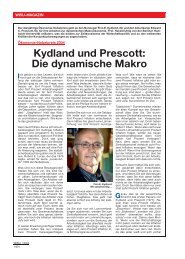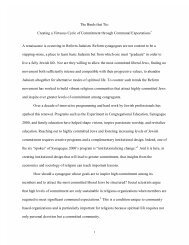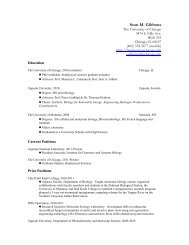Guide to the Study of Early Modern European History For Students ...
Guide to the Study of Early Modern European History For Students ...
Guide to the Study of Early Modern European History For Students ...
Create successful ePaper yourself
Turn your PDF publications into a flip-book with our unique Google optimized e-Paper software.
does "early modern" begin, and when does it end? Which areas <strong>of</strong> Europe does it include,<br />
and why <strong>the</strong>se? Why not call <strong>the</strong> field "Renaissance and Reformation," as it used <strong>to</strong> be called<br />
in <strong>the</strong> past? What is special about <strong>the</strong> period 1300-1700? Is it not perhaps more appropriate<br />
<strong>to</strong> deal with <strong>the</strong> period 1450-1650? Or <strong>to</strong> divide early modern Europe in<strong>to</strong> two periods, such<br />
as 1350-1500 and 1500-1650? Such question are worth attention. <strong>For</strong> <strong>the</strong> purposes <strong>of</strong> this<br />
guide, however, I will take "early modern Europe" <strong>to</strong> mean <strong>the</strong> his<strong>to</strong>ry <strong>of</strong> <strong>the</strong> people living<br />
on <strong>the</strong> Eurasian promon<strong>to</strong>ry, <strong>to</strong> <strong>the</strong> West <strong>of</strong> <strong>the</strong> Urals, from <strong>the</strong> fourteenth <strong>to</strong> <strong>the</strong><br />
seventeenth centuries, with occasional excursions backward and forward in time, but with<br />
little emphasis on <strong>the</strong> regions east <strong>of</strong> <strong>the</strong> Oder and <strong>the</strong> Adriatic.<br />
<strong>Students</strong> <strong>of</strong>ten want <strong>to</strong> know how many books and articles <strong>the</strong>y ought <strong>to</strong> read. The<br />
honest answer is: as many as <strong>the</strong>y can. The reading lists <strong>of</strong> students who have taken <strong>the</strong>ir<br />
exams with me have ranged from about thirty books and fifteen articles at <strong>the</strong> low end <strong>to</strong><br />
about eighty books and fifty articles at <strong>the</strong> high end. Thirty books is enough if early modern<br />
Europe is your second or third field. Eighty is more than enough, whe<strong>the</strong>r early modern<br />
Europe is your main field or not. Indeed, if reading eighty books forces you <strong>to</strong> delay your<br />
examination or does not allow you <strong>to</strong> gain a thorough grasp on what you are reading, eighty<br />
is <strong>to</strong>o much. That ought <strong>to</strong> give you as good a sense as it is possible <strong>to</strong> get before you have<br />
taken your exam.<br />
IV. STATEMENT OF INTENT<br />
Your first responsibility after having read through this guide is <strong>to</strong> write a statement<br />
<strong>of</strong> your intentions for <strong>the</strong> examination, so that I will know better how <strong>to</strong> guide your<br />
preparation. Your statement should identify <strong>the</strong> fields for which you are preparing yourself,<br />
<strong>the</strong> names <strong>of</strong> your prospective examiners, <strong>the</strong> date at which you intend <strong>to</strong> take your<br />
examination, and your current status in <strong>the</strong> department.<br />
Next, give me two separate lists <strong>of</strong> books and articles. The first list should identify<br />
books in <strong>the</strong> field that you have already read. The purpose <strong>of</strong> this list is for me <strong>to</strong> get a sense <strong>of</strong><br />
what you've made yourself familiar with at one time or ano<strong>the</strong>r, regardless <strong>of</strong> whe<strong>the</strong>r or not<br />
you still remember what you've read. The second list should contain whatever you intend <strong>to</strong><br />
read in preparation for <strong>the</strong> exam and <strong>the</strong> time when you intend <strong>to</strong> read it. Organize both lists<br />
according <strong>to</strong> <strong>to</strong>pics; list primary sources separately from secondary sources; and put asterisks<br />
next <strong>to</strong> books you know well in order <strong>to</strong> distinguish <strong>the</strong>m from books you have only<br />
skimmed or read <strong>to</strong>o long ago <strong>to</strong> remember.<br />
I would also like you <strong>to</strong> give me lists <strong>of</strong> <strong>the</strong> readings you will be doing in your o<strong>the</strong>r<br />
fields. If those lists aren't ready yet, give <strong>the</strong>m <strong>to</strong> me when you can.<br />
The main point <strong>to</strong> keep in mind when you compose your reading list is that you<br />
should aim at two goals: a judicious balance between feasabilitly and coverage <strong>of</strong> <strong>the</strong> five<br />
different kinds <strong>of</strong> knowledge mentioned above. Be realistic. Make a list <strong>of</strong> every major task<br />
you will need <strong>to</strong> accomplish by <strong>the</strong> time your exam comes around (including your<br />
preparation for o<strong>the</strong>r fields), estimate <strong>the</strong> time you will have available for this field, and<br />
figure out how many pages, titles, and books you will be able <strong>to</strong> digest in that amount <strong>of</strong><br />
time, perhaps on a weekly basis.<br />
Be prepared <strong>to</strong> change both your reading list and <strong>the</strong> timetable as you go along. You<br />
will read some books more quickly than o<strong>the</strong>rs, depending on <strong>the</strong> nature <strong>of</strong> <strong>the</strong> material and<br />
your progress <strong>to</strong> that point; you will skim entire volumes here or study every line <strong>the</strong>re; and<br />
you will omit certain titles from your reading list al<strong>to</strong>ge<strong>the</strong>r while adding o<strong>the</strong>rs that have<br />
8<br />
8



